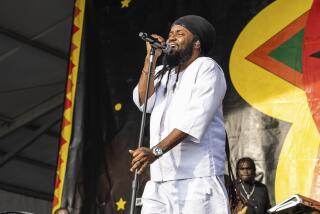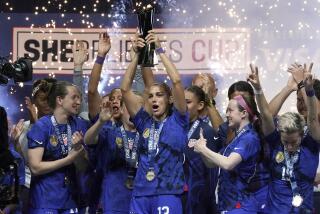The Morgan Gallops a Special Path : Equines: Members of the breed were at Gettysburg and Little Big Horn. It is the first truly American horse, and it is being preserved in a breeding program.
- Share via
STORRS, Conn. — They are symbols of pride, this small band of horses.
Their common ancestor was named Figure, a smallish, handsome equine, given to settle a debt in the late 1700s, strong enough to plow rocky hillsides or pull a log with three men on it, but fast enough to win prizes at the race.
Figure’s descendants rode and fought from Gettysburg and Shenandoah to Appomattox. One was the only survivor at the Little Big Horn.
They served the U.S. Cavalry until the horse soldiers dismounted in 1943 to take up sturdier chargers like tanks and armored vehicles.
But they survive here in New England in a special breeding program at five state universities, including the University of Connecticut.
At the UConn horse barn, four Morgan horses originating from U. S. Cavalry lines already have been born this year. Three or four more are expected by year’s end.
The Morgan is widely considered to be the first truly American breed, named after Justin Morgan, a schoolteacher, professional musician and tavern owner who moved from West Springfield, Mass., to Randolph Centre, Vt., in 1788.
When Morgan returned to West Springfield in 1795 to collect a debt, he was given two horses in lieu of money.
One was Figure, a 2-year-old Bay colt, an unusually strong, even-tempered and tireless animal.
Figure, later renamed Justin Morgan, died in 1821, having served numerous masters in his 28 years. Although the facts and caliber of his own lineage were unknown, his legacy is priceless.
Morgans are relatively small, averaging about 15 hands and usually weighing about 1,000 pounds. Brown, bay, chestnut or black, they exhibit a sturdy elegance that in the 19th Century made them horses of choice either in front of a plow or carriage or mounted in battle.
Today, they have made the UConn horse barn a popular gathering place, especially when the young foals can be seen teetering and tottering near their mothers in the surrounding fields.
The youngest Morgan foal was born on May 5, bred from a 7-year-old Morgan mare named Merwin’s Black Beauty and a 5-year-old Morgan stallion, Doc Daniels.
The small bay colt, with his large eyes and already graceful build, still wobbles a little in the stall with his mother, but is shedding his bowlegged awkwardness fast. Kathy Pelletier, assistant manager of the horse barn, says looking at the foal makes her feel proud that UConn is preserving the cavalry tradition.
“Once they’re gone, that’s it. You can’t bring them back,” she says. “It’s like the whales. And these are very special horses.”
The colt has yet to be named, but Pelletier is sorting through a list of suggestions scrawled on a sign-up sheet by visitors. Favorites so far are Doc’s Image, Black Daniels and Willow.
Students work with the horses from foaling time through training. They travel around the country to horse shows and have active drill and polo teams.
About 125 students ride the horses each year.
“Maybe the interest in overall agriculture is waning, but the interest in horses seems to be increasing all the time here,” says James Dinger, an associate professor of animal science who runs the horse program.
The Morgan is “kind of a showy horse, a good parade horse with a good disposition toward people,” Dinger says.
They were originally prized as work horses, but life in the rough terrain of rural Vermont increased their endurance. And their light weight and swiftness made them perfect for war.
In the Civil War, Morgans in the First Vermont Cavalry fought at Appomattox, Gettysburg and Shenandoah. Union Gen. Phillip T. Sheridan spoke proudly of how his Morgan, Rienzi, fared in battle--and the horse was eventually stuffed and put on display at the Smithsonian Institution.
Troopers usually used their own mounts in the Civil War and Morgans were very popular.
“They stand the hardships of the campaigns better than any others,” the U.S. War Department reported during the war.
At Little Big Horn, a Morgan named Comanche was the only living thing at the scene after the battle.
At the start of this century, the federal government set up remounting stations, where farmers could bring their horses to be bred and the government would have the first option to buy.
But in 1907, Col. Joseph Battell, who started the Morgan Horse Register to trace the lineage of the breed, donated land in Weybridge, Vt., to the government--to be used to ensure the survival of the Morgan.
At the time the U. S. Government Morgan Farm was opened on Battell’s land, the breed seemed headed for dispersal and eventual disappearance.
In 1915, there were 15 million horses and mules in America. Of those, only between 3,000 and 6,000 of them were Morgans. By 1951, when the government farm closed down and became the property of the University of Vermont, the Morgans’ survival was virtually assured.
There are now about 70,000 Morgans in the United States, according to the American Morgan Horse Assn. in Shelburne, Vt.
While the university kept the Morgan farm open, much of the herd was dispersed in 1951 to the University of New Hampshire, the University of Massachusetts, the University of Pennsylvania and UConn.
Of its 65 horses, UConn has 40 Morgans, and breeds between five and nine each year. The horse program supports itself on the sale of horses, selling up to 40 annually.
Sally Wadhams, director of Youth and Education for the American Morgan Horse Assn., says the Morgans come close to being all things to all people.
“They’re tireless and enthusiastic to the point of going until they drop. Morgans want to do the right thing and they want to please.”
More to Read
Sign up for Essential California
The most important California stories and recommendations in your inbox every morning.
You may occasionally receive promotional content from the Los Angeles Times.











